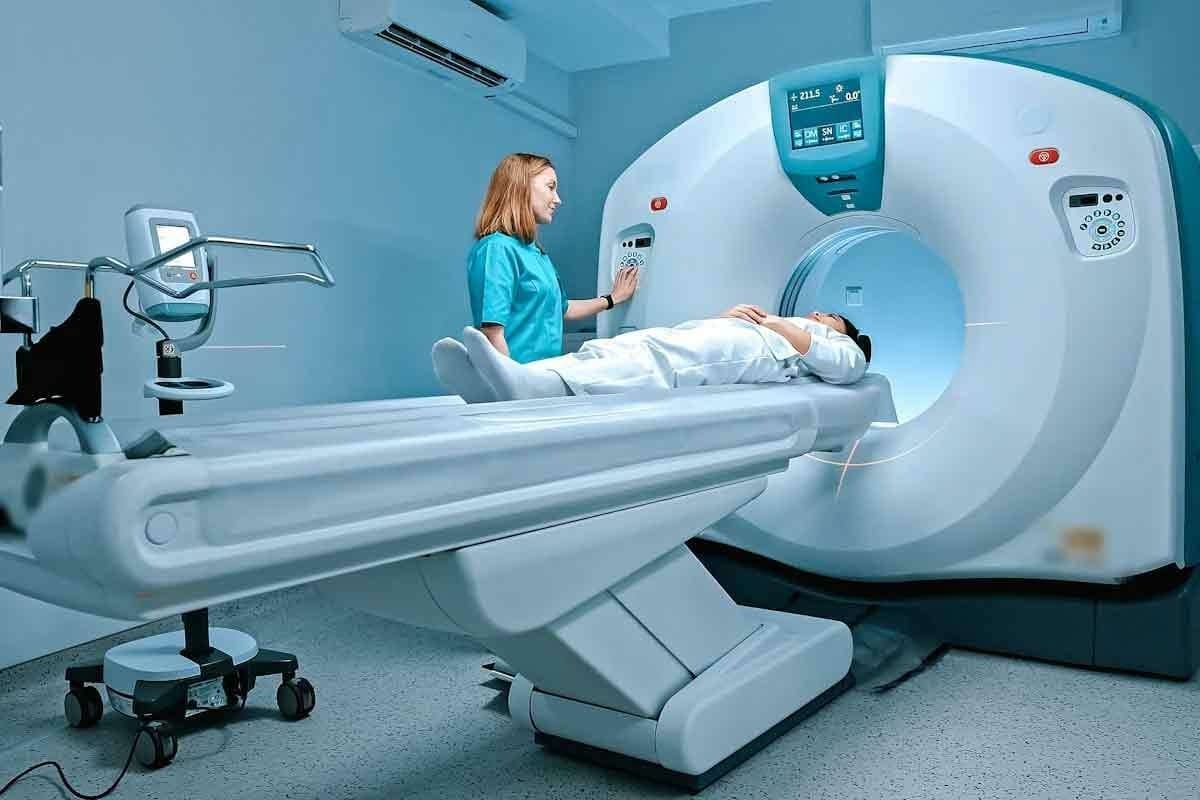Last Updated on November 26, 2025 by Bilal Hasdemir

Diagnostic imaging has changed healthcare a lot. It lets doctors see inside the body and find diseases without surgery. At Liv Hospital, we use the latest diagnostic imaging technologies to help our patients get better. Explore 7 powerful types of diagnostic imaging. Our guide explains essential medical imaging technologies and how they work.
Medical imaging like X-rays, CT scans, MRI, and ultrasound is key in healthcare today. These tools help doctors find and track diseases quickly and accurately. This leads to better care for patients.
We want to share all about the diagnostic imaging equipment and methods used in medicine. We highlight their role in giving top-notch healthcare. We also offer support and guidance to patients from around the world.
Key Takeaways
- Diagnostic imaging enables non-invasive disease detection and monitoring.
- Liv Hospital utilizes state-of-the-art diagnostic imaging technologies.
- Medical imaging diagnostics are critical in modern healthcare systems.
- Various diagnostic imaging equipment and techniques are used in medicine.
- Accurate diagnostic images lead to timely disease diagnosis and treatment.
The Role of Diagnostic Imaging in Modern Medicine

In today’s medicine, diagnostic imaging is key for accurate diagnosis and treatment planning. It uses various technologies to create images of the body’s inside. This helps doctors diagnose and track many medical conditions.
Definition and Purpose of Diagnostic Medical Imaging
Diagnostic imaging includes many methods like X-ray, CT, MRI, ultrasound, and nuclear medicine. These tools give vital info about the body’s inside. This info is key for making clinical decisions.
“Diagnostic imaging is vital in healthcare today,” says a key expert. “It helps us diagnose diseases early and accurately. It also lets us see how well treatments are working.”
How Imaging Technologies Guide Clinical Decision-Making
Each imaging method is best for different needs. For example, MRI is great for soft tissue, while CT scans are best for chest and abdominal issues. These technologies give detailed views of the body’s inside. This helps doctors:
- Diagnose diseases accurately
- Plan the right treatments
- Keep track of disease changes
- Check if treatments are working
Impact on Disease Diagnosis and Treatment Monitoring
Disease diagnosis and treatment monitoring are greatly improved by diagnostic imaging. It allows for early and accurate diagnosis. This can greatly improve patient outcomes.
For example, CT and MRI help in managing cancer, heart disease, and brain disorders. They help doctors make better treatment plans.
Effective treatment monitoring is another big plus. It lets doctors see how a disease is reacting to treatment. This helps in making smart decisions about treatment plans.
In summary, diagnostic imaging is essential in modern medicine. It supports diagnosing and managing many medical conditions. As imaging tech improves, its role in patient care will only grow. This shows how important these tools are in healthcare.
The Evolution of Medical Imaging Diagnostics

Medical imaging diagnostics has changed a lot over time. It has changed how we find and treat diseases. This change is thanks to new technologies and the need for better, less scary ways to diagnose.
Historical Development of Diagnostic Imaging
It all started with Wilhelm Conrad Röntgen’s discovery of X-rays in 1895. This led to the first imaging method, radiography. Later, CT scans, MRI, and ultrasound came along. These tools help us see inside the body and find diseases more easily.
The move to digital imaging was a big step. It gave us clearer images, less radiation, and the chance to share images online. This makes diagnosing and planning treatments faster and better.
Technological Advancements in Medical Imaging
Recently, medical imaging has gotten even better. New methods like elastography and photoacoustic imaging have been added. Elastography, for example, checks how stiff tissues are, helping find liver problems.
- Elastography: Measures tissue stiffness, useful in diagnosing liver fibrosis and other conditions.
- Photoacoustic Imaging: Combines optical and ultrasound imaging to provide detailed images of tissue structures.
- Advanced MRI Techniques: Include functional MRI (fMRI) and diffusion tensor imaging (DTI), which offer insights into brain function and white matter tracts.
Current State of Diagnostic Imaging Equipment
Today’s diagnostic imaging tools are top-notch. They keep getting better to show clearer images, scan faster, and make patients more comfortable. Modern CT scanners, for example, take high-quality images with less radiation. MRI machines also keep improving, with stronger magnets and new coil tech for better views of small things.
The use of artificial intelligence (AI) in imaging is a big deal. AI helps doctors spot problems they might miss. This mix of tech and medical know-how is changing medical imaging a lot.
X-Ray Radiography: The Foundation of Medical Imaging
X-ray radiography is one of the oldest medical imaging technologies. It’s essential in today’s healthcare. We use it to find many medical issues, like bone fractures and some organ problems.
Principles and Mechanisms of X-Ray Technology
X-ray radiography works by showing how different tissues absorb X-rays. Dense materials like bone absorb more X-rays, showing up white on the image. Softer tissues let more X-rays through, appearing gray or black. This helps doctors see inside the body and spot problems.
Today’s X-ray machines are much better. They use digital tech to make images clearer and use less radiation. Digital radiography systems capture images directly, making them easier to store and enhance.
Types of X-Ray Examinations
There are many types of X-ray exams, each for different body parts. Some common ones are:
- Chest X-rays to look at the lungs and heart
- Orthopedic X-rays for bone and joint issues
- Dental X-rays to check teeth and jaws
- Mammography, a special X-ray for breast imaging
Clinical Applications and Limitations
X-ray radiography is used in many ways, like finding fractures and guiding procedures. But, it has its limits. It’s not great for soft tissue imaging, and there’s a risk of radiation damage, mainly with repeated or high doses.
| Clinical Application | Description | Limitation |
| Fracture Diagnosis | X-rays are excellent for visualizing bone fractures and assessing their severity. | May not detect hairline fractures or stress fractures. |
| Foreign Object Detection | X-rays can identify swallowed or inserted foreign objects. | May not detect objects with similar density to surrounding tissue. |
| Guiding Medical Procedures | X-rays are used to guide catheters and other instruments during certain procedures. | Requires specialized equipment and trained personnel. |
In conclusion, X-ray radiography is a key tool in medicine today. It has its limits, but its wide use, low cost, and quick results make it vital in healthcare.
Computed Tomography (CT): Cross-Sectional Imaging Technology
CT scans are key in modern medicine, giving us clear views of the body’s inside. They help us see detailed images that are key for diagnosing many health issues.
How CT Scanning Works
CT scans use X-rays to make detailed images of the body’s inside. A CT scanner, shaped like a doughnut, moves around the patient. It measures how much X-ray energy the body’s tissues absorb.
Then, computers turn these measurements into images of the body’s cross-sections. We can look at these images one by one or make 3D models. This helps us understand the patient’s health better.
Types of CT Scans and Their Applications
There are many types of CT scans, each for different uses:
- Standard CT Scan: Used for many health checks, like finding injuries, cancers, and blood vessel diseases.
- CT Angiography: Uses contrast material to see blood vessels and find vascular problems.
- High-Resolution CT: Shows small details, like in the lungs, and is used for diseases like lung scarring.
CT scans are great for checking the chest and belly. For example, they can find the cause of belly pain by showing images of organs like the liver and spleen.
| Type of CT Scan | Primary Use | Key Benefits |
| Standard CT | General diagnostic purposes | Quick and detailed images |
| CT Angiography | Vascular disease diagnosis | Clear view of blood vessels |
| High-Resolution CT | Lung and small structure imaging | Early lung disease detection |
Benefits and Radiation Considerations
CT scans have many benefits, like fast imaging and clear pictures for accurate diagnosis. But, we must think about the radiation they use. We follow strict rules to keep radiation low while keeping image quality high.
“The use of CT scans has revolutionized the field of diagnostic imaging, providing clinicians with valuable information that guides treatment decisions.” – A Radiologist
For example, a CT scan’s radiation is like that from hundreds of chest X-rays. Though it’s a lot, the benefits of CT scans often outweigh the risks. This is true, even in emergencies or when diagnosing serious conditions.
Understanding CT scans and their uses helps us see their importance in medicine. As technology gets better, CT scans will likely become even more precise and safe for patients.
Magnetic Resonance Imaging (MRI): Advanced Soft Tissue Visualization
MRI technology is a key part of today’s medical imaging. It shows internal structures in great detail. This makes it essential for diagnosing and tracking many health issues.
Physics Behind MRI Technology
MRI works by using nuclear magnetic resonance. A strong magnetic field aligns hydrogen nuclei in the body. Then, radiofrequency pulses disturb this alignment.
As the nuclei return to their aligned state, they send out signals. The MRI machine captures these signals to create detailed images. This technology lets us see soft tissues clearly.
The ability to visualize soft tissues in high resolution is key. It helps in diagnosing brain, spine, and muscle problems.
Types of MRI Scans
There are many MRI scans for different needs:
- Functional MRI (fMRI): Sees brain activity by tracking blood flow changes.
- Magnetic Resonance Angiography (MRA): Shows blood vessels and spots vascular issues.
- Magnetic Resonance Spectroscopy (MRS): Looks at metabolic changes in tissues.
- Diffusion MRI: Tracks water molecule movement, useful for acute stroke detection.
Clinical Applications and Contraindications
MRI helps diagnose and monitor many health issues. Its detailed images help doctors make accurate diagnoses and treatment plans.
But, MRI isn’t for everyone. It’s not good for people with metal implants, pacemakers, or those who are claustrophobic. It’s important to tell your doctor about any metal objects before the scan.
We see MRI’s big role in modern medicine and patient care. Knowing how MRI works and its uses helps us value it more in medical imaging.
Ultrasound Imaging: Non-Ionizing Diagnostic Technology
Ultrasound imaging uses high-frequency sound waves to create real-time images. It doesn’t use ionizing radiation. This makes it great for many medical uses, like checking on babies and the heart.
Principles of Ultrasound Wave Propagation
Ultrasound sends sound waves into the body. These waves bounce off and return as echoes. The device captures these echoes to show what’s inside.
The sound waves are between 2 and 15 MHz. Higher frequencies mean clearer images but can’t go as deep. Choosing the right frequency is key for each test.
Types of Ultrasound Examinations
There are many ultrasound tests for different needs. Here are a few:
- Abdominal ultrasound: looks at the liver, gallbladder, and kidneys.
- Obstetric ultrasound: checks on the baby during pregnancy.
- Cardiac ultrasound (echocardiogram): checks the heart.
- Vascular ultrasound: looks at blood flow and finds vascular diseases.
Clinical Applications and Advantages
Ultrasound is non-invasive and doesn’t use harmful radiation. It shows images in real-time. These benefits make it perfect for many medical uses, like guiding procedures and checking organs.
| Clinical Application | Advantages |
| Obstetrics | Safe for fetal monitoring, real-time imaging |
| Cardiovascular | Assesses heart function, non-invasive |
| Abdominal | Evaluates organ pathology, guides biopsies |
We use ultrasound in many medical fields because it’s safe and versatile. As technology gets better, we’ll see even clearer images and better diagnoses.
Types of Diagnostic Imaging in Nuclear Medicine
Nuclear medicine has changed how we see inside the body. It uses special technologies to look at how the body works. We use these methods to find and treat diseases.
Positron Emission Tomography (PET)
Positron Emission Tomography (PET) is a top-notch way to see how the body works. PET scans use tiny amounts of radioactive tracers. These tracers help us see what’s going on inside the body.
We use PET scans to find and watch diseases like cancer and heart problems. They help us understand the body’s metabolic activity.
- Key Applications: Cancer diagnosis, neurological disorders, cardiovascular disease
- Benefits: Provides functional information, high sensitivity, and specificity
Single-Photon Emission Computed Tomography (SPECT)
Single-Photon Emission Computed Tomography (SPECT) is another key tool in nuclear medicine. SPECT scans use radioactive tracers too. But they catch single photons from the tracers.
We use SPECT scans for many things. This includes checking the heart, finding bone cancer, and looking at some brain issues.
- Key Applications: Cardiac function assessment, bone metastases detection, neurological disorders
- Benefits: Wide availability, cost-effective, provides functional information
Hybrid Imaging Technologies: PET/CT and SPECT/CT
Hybrid imaging combines different imaging types for better results. PET/CT and SPECT/CT mix PET or SPECT with CT scans. This gives us detailed info for better diagnosis and treatment planning.
| Hybrid Imaging Technology | Benefits | Applications |
| PET/CT | Combines functional and anatomical information, high diagnostic accuracy | Cancer staging, treatment monitoring, neurological disorders |
| SPECT/CT | Enhances diagnostic specificity, provides detailed anatomical information | Cardiac function assessment, bone metastases detection, infection imaging |
In conclusion, nuclear medicine has many imaging tools that help us understand the body. We keep improving these technologies to better diagnose and treat diseases.
Endoscopic Imaging: Direct Visualization Techniques
We use endoscopic imaging to see inside the body. This helps us diagnose and treat problems accurately. It lets us look at organs and spaces inside the body directly.
Types of Endoscopic Procedures
Endoscopy includes many procedures for different body parts. Some common ones are:
- Gastroscopy: Looks at the upper digestive tract
- Colonoscopy: Checks the colon
- Bronchoscopy: Sees the airways
- Arthroscopy: Examines joints
- Laparoscopy: Views the abdominal cavity
Each procedure is chosen based on the patient’s needs and the area to be examined.
Diagnostic and Therapeutic Applications
Endoscopic procedures are used for both finding problems and treating them. They help doctors see things like ulcers, polyps, or tumors. They can also do things like:
- Remove polyps
- Take biopsies
- Widen narrow passages
- Stop bleeding
A medical expert said, “Endoscopy has changed how we handle stomach diseases. It lets us find and treat problems early, without needing surgery.”
“High-definition endoscopy has made it easier to find and diagnose stomach problems.”
Advantages and Patient Considerations
Endoscopic imaging is good because it’s not very invasive. It means less recovery time and can be done without staying in the hospital. But, we also have to think about the patient’s comfort, safety, and any risks.
| Advantages | Patient Considerations |
| Minimally invasive | Patient comfort and anxiety |
| Reduced recovery time | Risk of complications |
| Outpatient procedures possible | Preparation and aftercare instructions |
Knowing the good and bad of endoscopic imaging helps doctors take better care of their patients.
Conclusion: Emerging Trends in Diagnostic Imaging Technologies
Diagnostic imaging technologies are key in today’s medicine. They help doctors find and treat diseases well. At Liv Hospital, we aim to lead in these advancements for top-notch patient care.
New tools like elastography and photoacoustic imaging are making diagnoses better. These new trends mean faster and more accurate diagnoses. This leads to better health outcomes for our patients. We keep our equipment up-to-date to offer the best care.
The world of diagnostic imaging is always changing. We will keep adding new technologies to our practice. This way, our patients get the latest in medical care. Understanding diagnostic imaging helps us use it to its fullest to improve health.
FAQ
What is diagnostic medical imaging?
Diagnostic medical imaging uses technology to see inside the body. It helps doctors find and treat diseases.
What are the different types of diagnostic imaging?
There are several types. These include X-ray, CT scans, MRI, ultrasound, nuclear medicine, and endoscopy.
How does X-ray radiography work?
X-rays create images by passing through soft tissues but not through bone. This helps doctors see inside the body.
What is the difference between CT and MRI scans?
CT scans use X-rays for detailed images. MRI uses a magnetic field and radio waves for soft tissue images.
What are the benefits of ultrasound imaging?
Ultrasound is non-invasive and shows real-time images. It’s great for looking at the fetus and heart.
What is the role of nuclear medicine imaging in disease diagnosis?
Nuclear medicine, like PET and SPECT, shows how the body works. It helps find and track diseases like cancer.
What is endoscopic imaging used for?
Endoscopy lets doctors see inside the body with a camera. It’s used for both diagnosis and treatment.
How has diagnostic imaging technology evolved over time?
Imaging technology has grown a lot. From X-rays to MRI and CT, it’s better at diagnosing and treating diseases.
What are the advantages of hybrid imaging technologies like PET/CT?
Hybrid technologies combine different imaging types. For example, PET/CT gives detailed images and functional information.
What is the significance of diagnostic imaging in modern medicine?
Imaging is key in modern medicine. It helps doctors see inside the body, diagnose, and monitor treatment.
What is elastography and how is it used?
Elastography measures tissue stiffness. It helps diagnose liver disease and cancer.
What is photoacoustic imaging?
Photoacoustic imaging uses laser light to create images. It shows tissue structure and function without harm.
References
- American Cancer Society. (2024). Signs & symptoms of teen cancer. https://www.cancer.org/cancer/types/cancer-in-adolescents/finding-cancer-in-adolescents.html
- National Cancer Institute. (2024). Adolescents and young adults (AYAs) with cancer. https://www.cancer.gov/types/aya
- Hussain, S. (2022). Modern diagnostic imaging technique applications and advances. PMC, https://www.ncbi.nlm.nih.gov/pmc/articles/PMC9192206/






